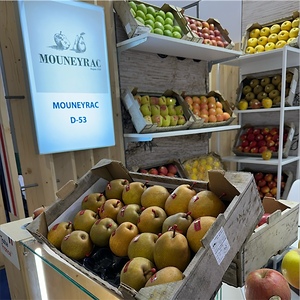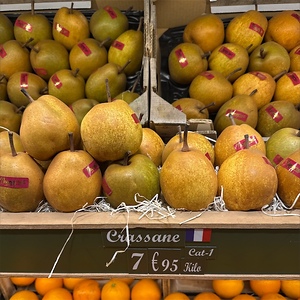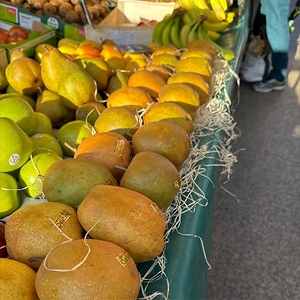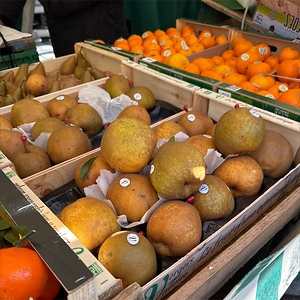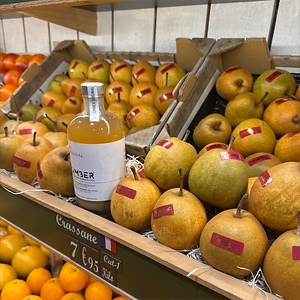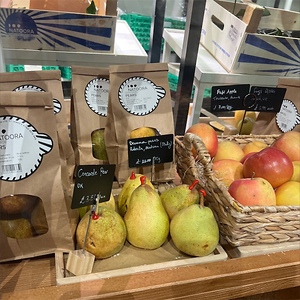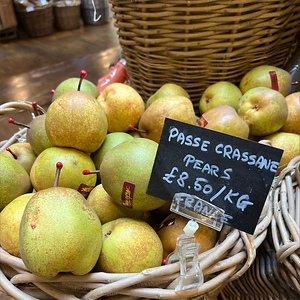

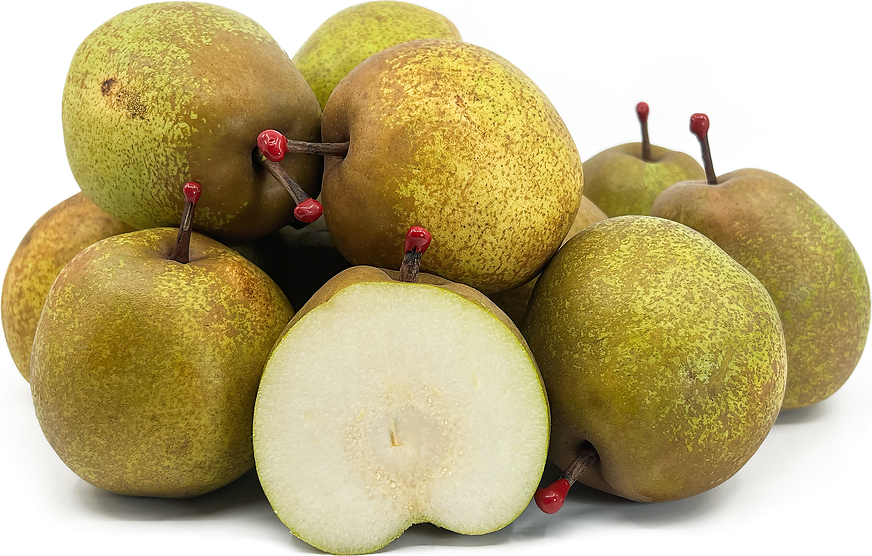
Passe Crassane Pears
Estimated Inventory, lb : 0
Description/Taste
Passe Crassane pears vary in size, depending on cultivation conditions, but are generally a medium to large varietal with a round, oval, to bulbous shape with a blunt, curved bottom and short, tapered top. The variety often has an irregular to slightly lumpy appearance and features a slender, woody, fibrous dark brown stem dipped in glossy, bright red wax. The skin is semi-thick, taut, and has smooth and rough patches. These rough patches are typically caused by a layer of brown russet, giving parts of the surface a textured, sandy feel, and each fruit will have its own unique amount. The skin also showcases green, light brown, and yellow hues and is covered in prominent speckled lenticels. Underneath the surface, the white to ivory flesh is firm when unripe, softening with maturity. The flesh also has a smooth, succulent, and aqueous consistency on the outer edges, while the center flesh around the core bears a slightly grainy, granular mouthfeel. The core extends the length of the fruit and encases a few seeds. Passa Crassane pears emit an aromatic, floral, and fruity fragrance once ripe. The variety is edible after a period of storage, and at maturity, the fruits have a pleasant, sprightly, sweet, tart, and vinous flavor.
Seasons/Availability
Passe Crassane pears are harvested in the fall, typically around late October. Once picked, the pears are stored for several months and sold in commercial markets in the winter through mid-spring. Passe Crassane pears have a peak season for fresh eating in February and March.
Current Facts
Passe Crassane pears, botanically classified as Pyrus communis, are an heirloom French variety belonging to the Rosaceae family. These late-season fruits are categorized as winter pears and are notable for their availability in markets in the spring when other pear cultivars have ended their season. Passe Crassane pears were once one of the most commercially planted varieties in France throughout the 19th century but have faded over time in cultivation due to disease, the introduction of improved varieties, and changing consumer habits. In the modern day, Passe Crassane pears are a rare cultivar sold as a specialty, seasonal fruit. One of the most distinguishing characteristics of the variety is their wax-sealed stems. The stems are dipped in bright red wax to seal in moisture and slow the aging process, and this feature is an easily recognizable symbol of the cultivar in markets. Passe Crassane pears are hand-picked from trees when they are still firm and are characteristically stored for several months to allow the fruits to soften and develop a sweeter flavor. Chefs and consumers seek the pears for their sweet, tangy flavoring and dense flesh. They are also favored for their versatility and are utilized in a wide array of fresh and cooked preparations.
Nutritional Value
Passe Crassane pears have not been extensively studied for their nutritional properties. Pears, in general, are a source of vitamins A and C to strengthen the immune system and maintain the overall health of organs. Pears also provide fiber to stimulate and regulate digestion and minerals such as potassium, phosphorus, calcium, and manganese. Potassium balances fluid levels within the body, while manganese aids in collagen production. Calcium and phosphorus support the body in protecting bone and teeth development. Antioxidants are found in the fruit’s peel to guard the cells against the damage caused by free radicals and reduce inflammation. Other nutrients in pears include lower amounts of iron, zinc, copper, B vitamins, folate, and vitamins E and K.
Applications
Passe Crassane pears have a fruity, floral, sweet, and tangy flavor suited for fresh and cooked preparations. Ripe Passe Crassane pears are primarily eaten out of hand and are popularly served with cheeses, nuts, and dried fruits on appetizer platters or as a light snack. Passe Crassane pears are also sliced and tossed into salads, added to fruit medleys, or used as a topping over oatmeal, parfaits, and pancakes. While less common, some chefs choose to layer slices of the pears into sandwiches for flavor and texture variation. Passe Crassane pears are customarily poached in wine, syrups, and chocolate sauces in France. One of France's most popular poached pear desserts is poire à la Beaujolais, or poached pears in a red wine, spice, and sugar mixture. Pears are also poached in chocolate in poires belle Helene throughout France or baked into pear clafoutis. In addition to poaching, Passe Crassane pears are served as a sweet accompaniment to foie gras, candied in syrup, or simmered into sauces. They are also used as filling for cakes, tarts, turnovers, and bars. Passe Crassane pears are known as Passa Crassana in Italy and are often cooked and served with honey or sugar in a recipe called pere cotte. Pears are also served with cheeses such as pecorino, blue, or gorgonzola on Italian cheeseboards. Worldwide, Passe Crassane pears complement other ingredients like spices, including cinnamon, star anise, cardamom, ginger, and nutmeg, vanilla, chocolate, and fruits such as blueberries, raspberries, citrus, and apples. Whole, unwashed Passe Crassane pears will keep for a few days at room temperature. Storage time fluctuates depending on how long the individual fruit has been held before reaching the market. Once the pears have reached their desired ripening, they should be immediately consumed for the best quality and flavor or stored in the refrigerator's crisper drawer.
Ethnic/Cultural Info
Passe Crassane pears were historically banned from cultivation for a brief period in France. The variety is susceptible to fire blight, scientifically known as Erwinia amylovora. Fire blight is a bacterial disease that affects apple, pear, and other plant species within the Rosaceae family. This disease infects trees during their blooming period and can lead to the flowers, branches, and leaves dying. Fire blight easily spreads between trees and can decimate orchards quickly as there is no easy way to contain it. Infected parts of the tree are removed from the plant, while some growers choose to spray a copper solution over the trees, which can be controversial. Other growers prefer to fully pull the trees from the orchard. During the 20th century, as fire blight continued to spread and impact orchards, the French government decided to ban the planting of susceptible cultivars in 1994, prohibiting growers from planting new Passe Crassane pear trees. Existing trees in orchards were allowed to be kept, and only fruits from established trees were sold in markets each year. This led to the variety almost disappearing from French markets, a stark contrast to the 19th century when the cultivar was one of the most produced pears. In 2021, the ban was repealed, and Passe Crassane pears once again became a variety available for commercial and home garden plantings.
Geography/History
Passe Crassane pears are native to France and were first grown in Rouen, the capital city of the Normandy region in northwestern France. Much of the variety’s early origins are unknown. Most sources note that it was planted in 1845 by a man named Louis Boisbunel, and the first fruits were harvested around 1855. After its introduction to commercial markets in France, Passe Crassane pears quickly spread in cultivation and eventually became one of the most grown varieties in the country during the 19th century. Later in history, Passe Crassane pears spread as a commercial cultivar to Spain and were planted in Italy after World War II. They were also introduced to England and Germany, where they became popular luxury items. In Italy, Passe Crassane pears were planted in the Emilia-Romagna region, where they became one of the pear varieties featured in the Protected Geographical Identification or PGI for the area. Passe Crassane pears were valued European pears for many years, but in the mid to late 20th century, they fell from favor and became a rare variety, only produced in limited quantities. Today, Passe Crassane pears are still grown in Europe and are also planted in home gardens and smaller orchards throughout the United States. When in season, Passe Crassane pears are found directly through growers, local markets, and select wholesalers.



